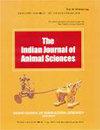Financial viability of Peste des Petits Ruminants (PPR) control programme (PPR-CP) implemented in Madhya Pradesh, India
IF 0.3
4区 农林科学
Q4 AGRICULTURE, DAIRY & ANIMAL SCIENCE
引用次数: 0
Abstract
Madhya Pradesh (MP) state in India had practiced focussed vaccination against Peste des Petits Ruminants (PPR) from 2006-07 to 2015-16 and adopted PPR-Control Programme (PPR-CP) with 100% coverage during first year followed by 30% bi-annual vaccination for two years since 2016-17. This study evaluated the impact of PPR-CP using secondary data and cross-sectional survey data collected from 410 and 340 flocks before (during 2015-16, survey-I) and after PPR-CP implementation (during 2018-19, survey-II), respectively. Besides the incidence and disease cost, Incremental Benefit Cost Ratio (IBCR) was calculated to assess the financial viability of PPR- CP implementation in MP state under actual vaccination coverage after PPR-CP (scenario-I) and as per defined PPR-CP strategy (scenario-II). The number of PPR affected flocks declined significantly from 14.9% to 4.6% and the disease incidence declined from 27.5% to 10.2% in sheep and 18.8% to 0.64% in goats, in survey-I and II, respectively. The projected loss before and after PPR-CP was ` 3260 million (` 326 crore) and ` 476 million (` 47.6 crore), respectively. Financial viability of PPR-CP revealed an IBCR of 69.8:1 and 39.4:1 under scenario-I and II, respectively. Estimated incremental benefits outweighed the incremental cost in both vaccination scenarios, however, as per current vaccination plan (scenario-I), no fresh cases were reported for two years following PPR-CP, but reoccurred during 2019-20, as the state did not comply with PPR-CP Strategy. Therefore, selecting the right vaccination strategy and its diligent implementation may aid in eradicating PPR by 2030 in India in line with PPR global strategy.在印度中央邦实施的小反刍兽疫(PPR)控制规划(PPR- cp)的财务可行性
印度中央邦从2006-07年至2015-16年实施了针对小反刍兽疫(PPR)的重点疫苗接种,并采用了第一年覆盖率为100%的小反刍兽疫控制规划(PPR- cp),随后自2016-17年起两年每年接种30%。本研究分别利用二次数据和在实施PPR-CP之前(2015-16年,调查i)和之后(2018-19年,调查ii)收集的410只和340只鸡群的横断面调查数据,评估了PPR-CP的影响。除了发病率和疾病成本外,还计算了增量效益成本比(IBCR),以评估在小反毒-CP(情景一)和确定的小反毒-CP战略(情景二)下,在多MP州实施小反毒-CP的财务可行性。调查1和调查2中,小反胃病感染畜群数量从14.9%下降到4.6%,绵羊发病率从27.5%下降到10.2%,山羊发病率从18.8%下降到0.64%。PPR-CP之前和之后的预计损失分别为32.6亿卢比(32.6亿卢比)和4.76亿卢比(47.6亿卢比)。PPR-CP在情景1和情景2下的IBCR分别为69.8:1和39.4:1。然而,根据目前的疫苗接种计划(情景i),在PPR-CP后的两年内没有报告新的病例,但由于该州没有遵守PPR-CP战略,在2019- 2020年期间再次出现病例。因此,选择正确的疫苗接种战略并积极实施,可能有助于印度根据小反刍兽疫全球战略,到2030年根除小反刍兽疫。
本文章由计算机程序翻译,如有差异,请以英文原文为准。
求助全文
约1分钟内获得全文
求助全文
来源期刊

Indian Journal of Animal Sciences
农林科学-奶制品与动物科学
CiteScore
0.60
自引率
25.00%
发文量
220
审稿时长
8 months
期刊介绍:
Articles published in The Indian Journal of Animal Sciences encompass a broad range of research topics in animal health and production related to cattle, buffalo, sheep, goat, camel, equines, pig, rabbit, yak, mithun, poultry and fisheries. Studies involving wildlife species and laboratory animal species that address fundamental questions about their biology will also be considered for publication. All manuscripts must present some new development and must be original, timely, significant and scientifically excellent. Papers will be rejected if standards of care of, or procedures performed on animals are not up to those expected of humane veterinary scientists. At a minimum, standards must meet the International Guiding Principles for Biomedical Research involving Animals, as issued by the Council for International Organizations of Medical Sciences. (C.I.O.M.S., c/o WHO, CH 1211 Geneva 27, Switzerland). Articles reporting new animal disease must follow GOI directive as given in detail in Guidelines to Authors.
 求助内容:
求助内容: 应助结果提醒方式:
应助结果提醒方式:


